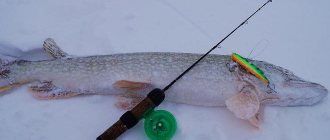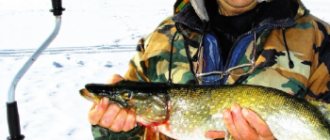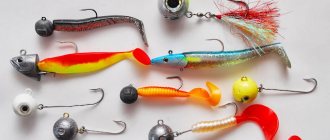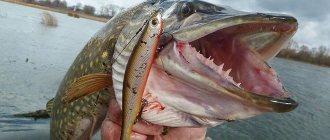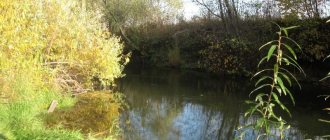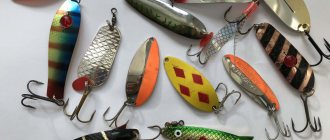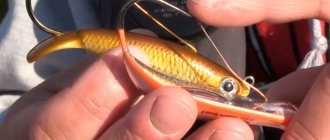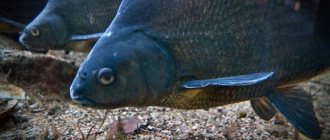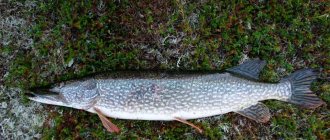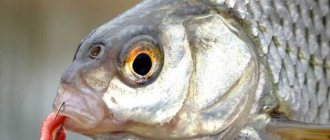To successfully catch pike in the grass, it is not enough to take a non-snagging bait and throw it into the first bushes you come across. There are special tactics and fishing techniques in the thickets. This does not mean that there will be pike in any grass. However, the presence of a predator in reeds and underwater mud, especially in summer, is more likely than in open water. Let's take a closer look at how to catch pike in the grass using spinning rods and live bait, where to look for pike and what baits to use.
Pike in the thickets - when and why
The abundance of green reeds, duckweed and algae always attract fish and aquatic invertebrates. Small grass pike graze in these lands until they grow up. The large one occupies grassy shallows, usually at the beginning of the warm season - with warming water in the spring and until the end of summer, beginning of autumn. Coastal thickets of water lilies, outcrops of reeds in the depths, windows of thickets - in the summer you can find a trophy toothy beast here, and not only on deep edges and snags.
- Seasonal migrations of pike from the depths to the grass and back are obvious in some reservoirs, but not in others. For example, on small rivers and shallow ponds, where there are no classic pike snags and holes, you need to look for the predator in or near the thickets throughout the entire season.
- Grass thickets attract the spotted hunter not only because of the abundance of food. Grass and algae are natural shelter for pike. Pike is an ambush predator ; it prefers to stand in a convenient place, waiting for its prey, rather than chasing it, like a perch or asp.
- Pike does not particularly favor heat and bright sun, preferring to stay in the shade and coolness of the water thickets. Only in autumn or early spring, warm sunny weather can, on the contrary, provoke the predator to come out. In summer, she usually hunts at dawn or in cloudy weather, when the light level drops .
- An obvious advantage of summer pike fishing with a spinning rod is that you can catch it in the grass during the day in the heat, on a bright sunny day. While on open water - only in the morning and evening, or if it is cloudy.
Why does pike need grass in the first place?
First of all, grass for pike is a kind of incubator. Although there are some other options for spawning sites, grass is the main one for this matter. It serves not only for laying eggs, but is also a kind of farm, where it is relatively safe, comfortable and satisfying. The period between the emergence of larvae from eggs and the transition of most newborn pikes to pure predation, although extremely interesting, I will allow myself to skip it.
Deep and grass pikes
Let's assume that some of the pike have reached the age of 3-4 months. These are such cute pikes that fit in the palm of your hand. At this moment, the pikes experience something like a transition to a new level of behavior and feeding. Here they are divided into two main camps: some leave the grass and go into open water, while others remain. This is how pikes appear, which we will later call deep and grass pikes.
This is a very arbitrary division, but it is a fact: the pikes are separated, those that went into open water grow faster (due to a better fish diet), and those remaining in the grass grow more slowly. And already at this age a difference in length can be observed, when “deep” pikes are almost one and a half times longer than “grass” pikes.
This division is characteristic of many animals and is currently being carefully studied. Based on the results of some studies, it can be said without exaggeration that fish (and pikes in particular) have what in the human world is called a personality. That is, even within the same clutch of eggs, more aggressive and less aggressive fish appear. Or, if you prefer, bold and timid. How this happens is unknown. However, this is confirmed not only in the scientific world, but also in the fishing world.
I’m sure many of us have had surprises like catching a “three-finger line” with a heavy jig from a deep hole at a great distance from the obvious “line kingdoms”. So, these small pikes are not random losers - these are exactly those brave and aggressive pikes that will later become trophy fish. However, this lifestyle (excessive risk, aggression and ignoring protection) is not beneficial to health and many of them become victims of larger relatives without ever reaching puberty. But these are nuances.
Worth reading: Pike in troubled water. And other fish there too
Grass is not just grass
Separated pikes also differ in physical activity. In general, there is an expression: pike is a typical ambush predator. This is often understood as literally ambush hunting. They say the pike sits and waits until something tasty swims past. In principle, this is true, but not entirely. The pikes are moving. A lot of. And “deep” pikes move more actively than “grass” pikes.
They can distinguish two large types of migration: vertical and horizontal. The last one is the distance in length. For example, during spawning, many pike can travel long distances. From available research, partial maxima of 20 and even 60 kilometers can be identified. But this is spawning and there is nothing you can do about it. However, even in ordinary life, many pikes do not sit still.
They have something like a territory, the “perimeter” of which they constantly go around, eating up “intruders” here and there. The size of this territory is different for different pikes, and so far we can speak more or less confidently about the dependence of the size of the territory on the size of the fish: the larger the pike, the larger the territory under its control. In fish of younger ages, the size of territories varies greatly and there is no obvious proportion yet.
At the same time, shallow areas with grass may be included in the list of objects visited by pike during patrolling. In other words, mom comes in to see what her kids are doing, where she gives the particularly naughty kids a fascinating tour of their digestive system. Thus, catching a really large fish in the lace kingdom or somewhere nearby should not be surprising.
Vertical migration is the movement of pike through depths. The pike performs this action (obligatory, by the way) up to several times a day, depending on the season. It has little to do with feeding and the main reason is the structure of the pike’s body.
Pike is a so-called mesothermic animal. That is, something that is between warm-blooded and cold-blooded. This means that depth migration is necessary for pikes to maintain optimal temperature balance. For example, in winter they need warmer water to hunt effectively. In summer the picture is the same and you can even observe funny things, like night accumulations of pike on shallow beaches. And with this migration things start to get interesting.
Location of pikes in the grass and floor system
Once in one of the old “herbal” articles the following statement was given. Passive pikes stand in the grass near the bottom, active pikes are closer to the surface and in the middle - inert, ready to eat, but in no hurry to do so. That is, it turns out to be three floors. In fact, everything is much more complicated. In a nutshell, the distribution of pikes among specific floors depends very little on feeding activity.
Despite the fact that pikes have some synchronicity and a “schedule” that is approximately the same for each individual, each specific pike occupies a certain floor for a separate set of reasons. Moreover, on the same patch, two identical pikes can occupy different positions.
For example, a passive pike may be at the top, and an active one at the bottom. And these are not exceptional cases, this is a matter of individual reasons and conventions. Moreover, on some reservoirs (I have most often seen this on floodplain lakes), the most active pikes were right at the bottom. If we talk about adult fish.
This is not easy to explain, but there is an assumption. Pike choose a position for ease of control over the surrounding space. Fish standing below the surface are completely blind to what is happening below them. For them, a very small horizontal viewing angle remains and, accordingly, fewer potential victims fall into their field of view.
And a completely different picture when the pike is standing below. The belly is covered with a safe bottom, and the eyes see a large space on the sides, in front and above. But for pike, a “visual” predator, it is very important to see as much as possible. This both increases the efficiency of feeding and reduces the likelihood of predation on the pike itself.
Worth reading: The structure of the river. Advanced reading, connections and practical use
In addition, certain periods create additional risks for subsurface pike.
At the end of summer, in many reservoirs, hornwort begins to break away from the ground and float up. In thickets of egg capsules, this hornwort very quickly clogs the already insignificant open spaces between large leaves. It was already gloomy in such places before, but now the light is almost completely blocked.
What does this give? This provides greater camouflage opportunities for larger pikes hunting from below. And when there is a risk of being eaten, caution is activated. Pike feel each other very well and very quickly learn about the presence of larger (and smaller, of course) relatives. Especially if they have recently had a snack.
And if a large pike eats another pike, the pikes standing nearby reduce their activity. There are also studies on this issue where this clear pattern is noted. Thus, pike standing under the surface can hide, greatly reducing their movements, and simply bask.
In fairness, it is worth noting that the statement given at the beginning of the chapter also holds true. And the indicated distribution by floor (passive at the bottom, active at the top) can also be justified. This picture very often develops at the height of summer, when plants are at the peak of their development.
At this time, the grass has its own special distribution of oxygen in depth. And the contrast can be very sharp when there is a lot of oxygen on the surface, but near the bottom there is almost starvation. Moreover, this also occurs at shallow depths of one and a half to two meters.
Support the project!
Spinning in the bushes
Tactics for catching pike in the grass with a spinning rod are based on the basic principles of search and knowledge of pike behavior. The toothy one needs to be looked for, seduced, and experimented with wiring. If you get the right bait into the ambush zone of a pike and tempt it into aggression, you can get a bite even when it is not feeding.
However, not every thicket of reeds, sedges or algae is promising - you need to be able to look for pike, paying more attention to specific promising points. In addition, not all reeds, due to their density and location, are accessible to fishing. Naturally, when targeting thicket fishing, you need to take into account the basic principles of fishing with a spinning rod for pike
Promising places
Fishing for pike in the grass on small rivers - searching and quickly catching the most promising places. Such reservoirs abound in places where, in the opinion of the fisherman, pike can lie in ambush. However, sometimes you need to walk kilometers and cast hundreds of points to catch a good pike - especially in places frequented by anglers.
On an unfamiliar body of water, it is better to spend time searching and checking many places than to stand on a convenient platform and uncontrollably hit one point with a spinning rod. You need to be able to read a body of water; unpromising places can simply be passed by.
Promising points:
- Transitions from depth to shallows before and after rifts, overgrown with long underwater algae. In hot weather, pike can stand in this grass and on the rapids themselves, in the current.
- Thickets of sedge and reeds at the confluence of channels and tributaries.
- Separate algae and reed islands at sufficient depth.
- Entrances and exits from grass pits
- A wall of reeds extending into the depths.
- Coastal thickets of water lilies.
- On large bays overgrown with water lilies - in windows and on the border with clean water.
- Local snags, windows, piles of plant debris.
- On completely overgrown ponds, bets and bays, it is better to fish from a boat, checking the windows and areas that allow you to cast a spinning rod.
- Fully overgrown toad grasses, covered with duckweed, also become a haven for pike - if there is something to eat there.
- Catching pike in thick grass on shallows can be successful in the spring, when the toothy one comes out to bask in the sun. With the onset of heat, it is better to look for it at a depth of at least about a meter, where it is cooler.
- On rivers and reservoirs, a large number of pike in warm weather move closer to the shore - to overgrown bays, which serve as a refuge for forage crucian carp, roach and perch.
Fishing tactics and techniques
Directly on the reservoir, the tactics of working with a spinning rod depend on the configuration of the thickets and the set of available non-hooking baits. Some can be fished in the grass conditionally - you need at least a meter of depth and free passages. On surface hooks and an unloaded jig you can squish almost anywhere where the reeds do not grow in a continuous thick wall.
Having a boat makes fishing easier. It is not always possible to get to a promising point from the shore, but by boat you can simply sail to any place. In some water areas you can get to the windows by wading in waders or waders.
Fishing for pike in the grass should be combined with checking clean areas nearby with regular bait. That’s why a boat is needed – so as not to lose expensive wobblers and favorite lures. Often the seemingly clear strip of water near the reeds is filled with snags, remnants of last year's vegetation and mud - classic pike grounds.
Fishing in the grass is not a separate event, but an addition to regular spinning fishing on the net. The approach is the same - we experiment with baits and wiring. On any bait you can use uniform, intermittent or jerky wiring. The jig does not work in the usual position - we hook it in the lateral plane or generally according to the wacky principle. It can be difficult to persuade a well-fed summer pike to bite.
With experience comes an understanding of which window to throw the bait into. Sometimes it takes longer to get to it than it takes to catch it, breaking through the thicket. And the very first cast sometimes rewards the toothy one, which is intractable in open water.
Time
I’m sure many people know about the so-called daily peaks of pike activity: morning and evening. They are also confirmed by research. And although these peaks (3 hours in the morning and 4 in the evening) are very pronounced, in the middle of the day you can find quite active pike. This information is very often used in grass fishing. However, you shouldn’t do this, because this is a completely different story.
The activity peaks themselves do not go away, but they very much depend on the transparency of the water and the light level in general. Thus, we can observe their maximum work on clear days in reservoirs with clear water. On a cloudy day or in muddy water, these peaks either stretch out over longer periods or go completely unnoticed when the fish bite all day. The so-called pike weather is just about this.
In the grass, even if the pond has very clear water and the day is clear and sunny, the illumination is lower. And it will decrease with increasing grass density. For example, fields of egg pods are dark “rooms” in light spaces. And in conditions when hornwort emerges at the end of summer, the grass becomes even darker. On the one hand, this alone gives a reason to sleep longer and go fishing in the grass only at lunchtime. But there is a more serious factor than light - oxygen.
From a school textbook we remember something like this: “all plants produce oxygen with the help of light.” And it seems to us that grass in water is the most oxygen-rich place.
But there is a problem: plants produce oxygen during the day, but at night, on the contrary, they absorb it, releasing carbon dioxide. In water in overgrown areas, this means daily sharp jumps in the amount of dissolved oxygen from one extreme to another.
Moreover, even such phenomena as summer night death are known. They happen in heavily overgrown areas. Moreover, the less light enters the water column (the denser the layer of grass on the surface, duckweed and burdocks), the less oxygen there is in the water.
In a practical sense, this means that during the usual morning time for the summer peak of activity, grass pike will have a headache from oxygen deprivation.
In other words, the fish in the grass turn on much later. For example, if in open water a pike begins to eat well at 4 am, then in the same reservoir in an area with grass the pike will be inactive until 9-10 o’clock. And the denser the grass and the larger the area, the more this time shifts. Thus, the period of effective fishing in the grass is greatly reduced.
Worth reading: Modern species of pike and where to catch them
There is also an important nuance. The thicker the grass and the farther the point is from open water, the later the pike starts there. So if you still get up early, then the first hours of fishing should be spent combing the open water somewhere near the grass with ordinary baits. For example, wobblers.
At the same time, it is important not to be deceived by the activity of some rudd at the surface at dawn. In the grass, these fish can already splash happily and actively eat in the morning twilight. However, it is important to understand that they live near the surface, where there is, in principle, more oxygen and night frost, even severe, does not particularly bother them.
Spinning equipment
For pike fishing in the thickets, it is better to increase the caliber of the spinning rod, up to 40-50 grams according to the upper test. With an ordinary average spinning rod of 20-30 grams, you need to handle it carefully, especially when fishing, so as not to break it. Sometimes you have to drag the pike out. Therefore, a powerful short, fast-action spinning rod with a braid of at least 15 LB 0.14 mm is more suitable for such fishing. The cord can be placed even thicker - up to 0.2 mm; in overgrown water areas it will not arouse suspicion in the pike.
Unhooked lures
We have already discussed how and what to use to catch pike in the grass in the article about the right non-snagging lures for pike. Here we will touch on more tactical and technical issues. Conventionally, when fishing in thickets, two groups of conditions are distinguished. This is free water for fishing in the thickness with sparse thickets and completely overgrown areas with rare windows. If lures for working in thick water can be used only in the first case, then surface jigs and unloaded jigs can be used in any variant.
For wiring in thick areas
If there is a volume of water at least half a meter thick and several meters long, you can hold a regular spoon or wobbler in this layer, above the carpet of algae. Every angler has his favorite proven spinners or wobblers. A jig with light heads or unweighted is good for this. You need to select a speed for moving the bait so that it does not cling. With a jig without a tee on the belly, you can literally scrape across this carpet.
Despite the hype raised by marketers around special non-hooking baits, it is better to use regular proven spoons and spinners, modified for fishing in the grass. This issue is discussed in detail in the article about non-hooking .
- With modified hooks - tees with antennae or offset hooks with silicone, the spoon can be carried through conditionally clean water filled with sparse vegetation and mud. In most light hooks on an obstacle, a slight twitch releases the bait and the retrieval continues.
- The bait can be held gently by shaking and twitching as it touches the grass.
- If it catches soft algae, we try to fish by pulling, cutting through the mud with sharp jerks of the rod. This is the so-called deep-diving pike fishing. But for this you need a hard leash, made of guitar string, and not a soft braided one.
In addition to conventional oscillators and turntables converted to non-engaging, we also try:
- An unweighted jig or hinged on an offset jig with a hook pressed to the body of the bait. These are any twisters, vibrotails, crustaceans. For large pike, larger silicones are better.
- Special planing lures without hooking.
- Squelching poppers, crawlers, walkers - in separate windows.
- Spinnerbaits are special baits that are essentially hook-free due to the voluminous skirt on the bait.
- Jig rigs for brush – drop shot, Florida, Carolina or Texas rigs.
Surface baits
For dense thickets, we use special baits for catching pike in the grass - gliders (Croatian egg) and silicone imitations: non-hooking frogs, rubber duckies and mice. These baits can be pulled over the reeds and water lilies on top, dropping them into clean areas where bites usually occur.
We also fish relatively clean areas - in the same places where we have already checked with deep baits. Sometimes pike ignore the placement of baits in the depths, but actively take the splashes of eggs or frogs on the surface.
Catching pike with a Croatian egg and a silicone frog
Let’s take a separate look at catching pike in the grass using a Croatian egg and a rubber frog. There are two types of Croatian eggs: with and without a hole. It is thrown into clean areas near water lilies and thickets. The simplest fishing tactic is a uniform slow retrieve with long pauses. You can pause for up to 10 seconds near the water lilies. Pike sometimes look at this interesting bait for a long time, and then decide to attack. Therefore, you need to be patient and carry out the wiring in a leisurely manner.
If the pike is active, it is better to use a Croatian egg with a recess.
These baits are somewhat similar to poppers. The similarity appears when performing jerk wiring. The result is popping and splashing. This behavior of the bait provokes the pike to bite.
The Croatian egg is often used by spinning anglers when fishing in overgrown areas, when using other baits is very problematic. They have one drawback - a large number of idle bites. This is facilitated by the special location of the hook. However, many fishermen have adapted to this phenomenon, and when attacking, they do not rush to make hooks, but wait a little, allowing the pike to better swallow the egg.
Another effective surface bait for catching pike in standing and overgrown reservoirs is a silicone frog. It is included in the main diet of pike. Spinning fishermen use frogs of various sizes. Some models have feet, and some are equipped with stripes.
These are excellent non-snagging hooks that make it easy to perform slow retrieves with pauses and jerks. Fishing tactics are in many ways similar to Croatian egg fishing. Stops are also made near water lilies and windows between vegetation. The pike perceives a moving object as if it were a real frog. If you make small jerks and long pauses, you can count on active bites from the predator.
Float
Some fishermen prefer to catch pike with live bait using a float rod. Live baits are often used for pike along with regular float fishing, for crucian carp or roach. The best bait for catching pike in the grass is, naturally, a live fish caught right there. In some reservoirs, pike take on a live frog.
You need a powerful fishing rod, capable of pulling a predator out of the reeds without much fighting. Live bait is thrown into the windows so as not to tangle the tackle as a result of movements - into the middle of the window. When fishing from the shore, we shorten the working descent and position the rod so that the live bait does not drag the equipment under the shore. More information about fishing for pike with a fishing rod using live bait
Tactics for fishing in difficult places
In summer, the toothy predator is rarely found in clean areas of the reservoir. Plenty of cover creates ideal conditions for pike ambush. As a rule, fishing is difficult because the fish does not pursue the prey, but waits until it comes close to it.
Ideal points for a predator to ambush:
- edge of cattails and floating islands;
- clearings in duckweed;
- continuous carpet of hornwort;
- thickets of water lilies.
An important factor when searching for pike is depth. In summer, the spotted one hides in shallow waters, where there are plenty of small fish, tadpoles and frogs. The peak of activity occurs in the morning, although in cloudy and rainy weather pike can hunt during the day. After the spring rush, it is difficult to interest fish with artificial bait. To do this, you need to remember the key points of wiring. Monotonous animation tempts the predator more effectively, which distinguishes spotted fish from perch or pike perch. The drawing speed plays an important role. The artificial bait must work on the verge of failure, only in this case the fish comes out to attack. If you move the bait too quickly, the predator does not have time to make a dash out of the dense vegetation.
Read: Catching pike in winter with artificial baits
When fishing from a boat, the distance between the “anchors” is significantly reduced. One overgrown spot can be home to up to 5 toothy ones, so it is important to cover the area as densely as possible. In some cases, approaching a promising site from several sides helps. Thus, the angler changes the angle of presentation of the bait, which gives its results.
It is necessary to move along the coastline if fishing is on a large body of water or along the river bed if fishing is on a small river. Thus, spinners throw two banks from the center, having equal chances of success. On small rivers, anchors are practically not used, and fishing is carried out by rafting.
Mugs and girders
It is better to purposefully catch pike in the grass with live bait from a boat on a set-up or mug. Supplies of any type are suitable. However, when fishing in the reeds, free movement must be limited so that the toothy fish does not get pulled too far into the wilds.
When making equipment for catching pike in the grass, we make the equipment thicker - so as to literally tear the fish out of the grass. We place the mugs in windows or on the borders of the reeds, and we tie the stands to stakes or strong sedge.
Subscribe to the channel:
YouTube channel RYBAFAN
We are VKontakte
Time to catch pike in the grass
The predator is not always caught in the grass; in the spring there is very little vegetation on the reservoirs. During this period, fishing is carried out with the usual gear and bait for this season. From the end of May to the beginning of June, vegetation actively begins to develop and by the middle of the first summer month the reservoir can be completely covered.
Catching a pike in such thickets is not easy; spinning beginners can simply give up on such a body of water, but more experienced ones will still try their luck. Trophy specimens are rare, but a pike up to two kilos can easily be hooked. To do this, you need to be able to choose the components of the tackle correctly, as well as decide on the bait. In the grass, predators are caught with a spinning rod all summer; the grass can completely fall only in the fall.
